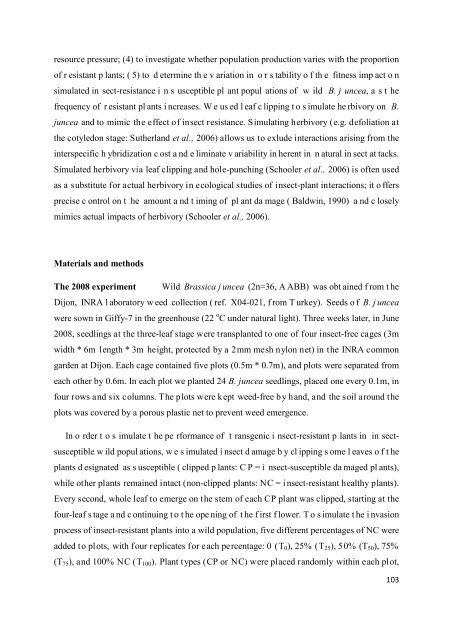UNIVERSITE DE BOURGOGNE THÈSE Yongbo LIU - Université de ...
UNIVERSITE DE BOURGOGNE THÈSE Yongbo LIU - Université de ...
UNIVERSITE DE BOURGOGNE THÈSE Yongbo LIU - Université de ...
Create successful ePaper yourself
Turn your PDF publications into a flip-book with our unique Google optimized e-Paper software.
esource pressure; (4) to investigate whether population production varies with the proportion<br />
of r esistant p lants; ( 5) to d etermine th e v ariation in o r s tability o f th e fitness imp act o n<br />
simulated in sect-resistance i n s usceptible pl ant popul ations of w ild B. j uncea, a s t he<br />
frequency of r esistant pl ants i ncreases. W e us ed l eaf c lipping t o s imulate he rbivory on B.<br />
juncea and to mimic the effect of insect resistance. Simulating herbivory (e.g. <strong>de</strong>foliation at<br />
the cotyledon stage: Sutherland et al., 2006) allows us to exlu<strong>de</strong> interactions arising from the<br />
interspecific h ybridization c ost a nd e liminate v ariability in herent in n atural in sect at tacks.<br />
Simulated herbivory via leaf clipping and hole-punching (Schooler et al., 2006) is often used<br />
as a substitute for actual herbivory in ecological studies of insect-plant interactions; it o ffers<br />
precise c ontrol on t he amount a nd t iming of pl ant da mage ( Baldwin, 1990) a nd c losely<br />
mimics actual impacts of herbivory (Schooler et al., 2006).<br />
Materials and methods<br />
The 2008 experiment Wild Brassica j uncea (2n=36, A ABB) was obt ained f rom t he<br />
Dijon, INRA l aboratory w eed collection ( ref. X04-021, f rom T urkey). Seeds o f B. j uncea<br />
were sown in Giffy-7 in the greenhouse (22 o C un<strong>de</strong>r natural light). Three weeks later, in June<br />
2008, seedlings at the three-leaf stage were transplanted to one of four insect-free cages (3m<br />
width * 6m length * 3m height, protected by a 2mm mesh nylon net) in the INRA common<br />
gar<strong>de</strong>n at Dijon. Each cage contained five plots (0.5m * 0.7m), and plots were separated from<br />
each other by 0.6m. In each plot we planted 24 B. juncea seedlings, placed one every 0.1m, in<br />
four rows and six columns. The plots were kept weed-free by hand, and the soil around the<br />
plots was covered by a porous plastic net to prevent weed emergence.<br />
In o r<strong>de</strong>r t o s imulate t he pe rformance of t ransgenic i nsect-resistant p lants in in sectsusceptible<br />
w ild popul ations, w e s imulated i nsect d amage b y cl ipping s ome l eaves o f t he<br />
plants d esignated as s usceptible ( clipped p lants: C P = i nsect-susceptible da maged pl ants),<br />
while other plants remained intact (non-clipped plants: NC = i nsect-resistant healthy plants).<br />
Every second, whole leaf to emerge on the stem of each CP plant was clipped, starting at the<br />
four-leaf s tage a nd c ontinuing t o t he ope ning of t he f irst f lower. T o s imulate t he i nvasion<br />
process of insect-resistant plants into a wild population, five different percentages of NC were<br />
ad<strong>de</strong>d to plots, with four replicates for each percentage: 0 (T0), 25% (T25), 50% (T50), 75%<br />
(T75), and 100% NC (T100). Plant types (CP or NC) were placed randomly within each plot,<br />
103
















